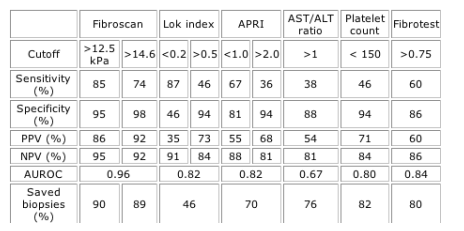 |
 |
 |
| |
What is the best non invasive method for early prediction of cirrhosis in chronic hepatitis C? Prospective comparison between Fibroscan and serum markers (Lok index, APRI, AST/ALT ratio, platelet count and Fibrotest)
|
| |
| |
Reported by Jules Levin
AASLD, Nov 2-6, 2007, Boston, MA
L. Castera1, 2; P. Bernard2; B. Le Bail3; J. Foucher1, 2; W. Merrouche1; P. Couzigou1; V. de Ledinghen1
1. Hepatology, Hopital Haut Leveque, CHU Bordeaux, Pessac, France.
2. Hepatology, Hopital St Andre, CHU Bordeaux, Bordeaux, France.
3. Pathology, Hopital Pellegrin, CHU Bordeaux, Bordeaux, France.
Background: Several non invasive methods have been proposed for the diagnosis of cirrhosis in patient with hepatitis C. They include routinely available markers (platelet count, AST/ALT ratio (AAR), AST to Platelet ratio (APRI), scores (Fibrotest (FT), Lok index (platelet count, AST/ALT ratio, and INR), and lately transient elastography (Fibroscan (FS).
Aim: to prospectively compare the performance of these different methods for the early prediction of cirrhosis in the same population of patients with chronic hepatitis C.
Methods: 305 consecutive HCV patients (males 57%, mean age: 52±12) who undergone a liver biopsy (>10 mm) were studied. All patients had FS, FT, APRI, Lok index, AAR and platelet count in the same lab the day of liver biopsy, taken as reference. Cut-offs used for each test were those defined in the original studies. Performances were compared in intention to treat analysis (FS failure was considered as need for liver biopsy).
Results: Significant fibrosis (Metavir F2-F3-F4) was present in 228 (75%) and cirrhosis (F4) in 77 (25%) (Child-Pugh A 90%; B 10%, oesophageal varices 39%). The mean liver biopsy length was: 19±8 mm. FS failure was observed in 10 patients (3%). Performances of the different methods are shown in the table.
32 out of 77 (42%) cirrhotic patients had no clinical or biochemical or US signs suggestive of cirrhosis. Among these 32 patients, cirrhosis could have been detected in 5 (16%) using the Lok index, in 5 (16%) using the AAR, in 8 (25%) using the APRI, in 14 (44%) using FT, and in 22 (70%) using FS, respectively. In addition, at a cut-off of 21 kPa, the performance of FS for detecting oesophageal varices was: Se 79%; Sp 72%, PPV 65%, and NPV 84%.
Conclusions: Fibroscan is the best non invasive method for prediction of cirrhosis in chronic hepatitis C, as compared with other available methods, saving the need for liver biopsy in 90% of cases. In patients without any signs of cirrhosis, early diagnosis can be made in 70% of cases.

|
| |
|
 |
 |
|
|